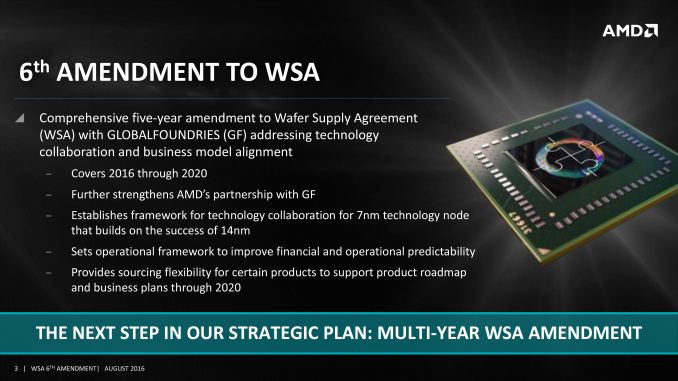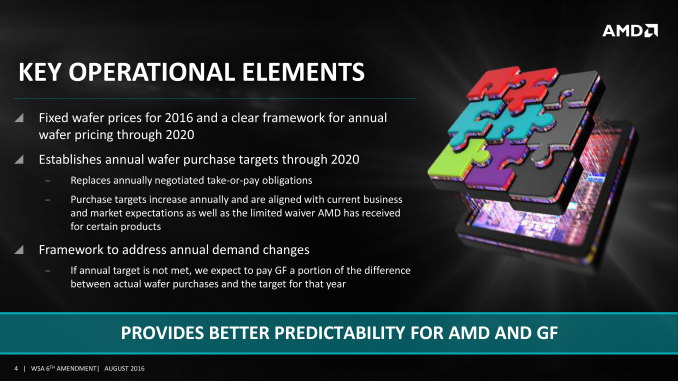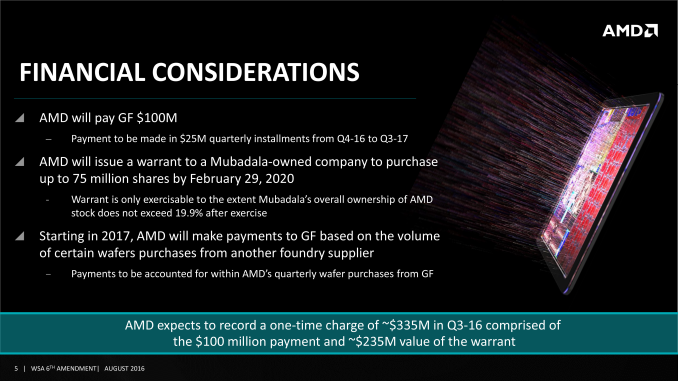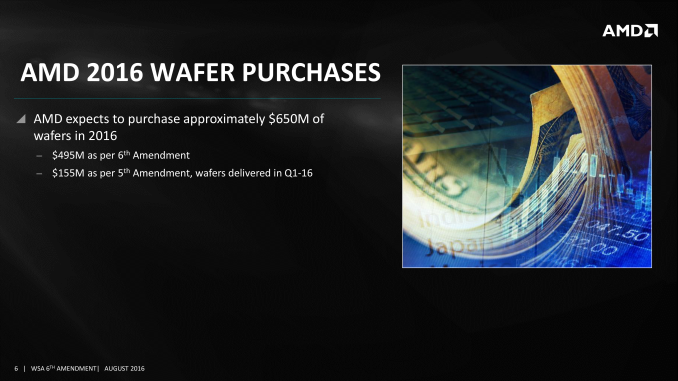AMD Amends GlobalFoundries Wafer Supply Agreement Through 2020, Gaining New Flexibility & New Costs
by Ryan Smith on September 1, 2016 6:00 AM EST- Posted in
- CPUs
- AMD
- GlobalFoundries
- APUs
- GPUs

This evening AMD has announced that they have updated their long-standing wafer supply agreement with fab parter GlobalFoundries. The new agreement, which makes some notable alterations to wafer order numbers and how the parties are compensated, covers wafer sales between the two parties through 2020.
As a bit of background here, of the many important and long-term consequences of AMD’s 2008 spin-off of their foundry business into what has become GlobalFoundries, perhaps the most significant is the Wafer Supply Agreement (WSA). As part of the plan for separating chip design and chip fabbing, AMD inked an agreement with GlobalFoundries that setup a basic framework for how many wafers AMD would buy. This essentially ensured that AMD would remain a long-term customer and GlobalFoundries a long-term supplier through the lifetime of the agreement.
The overall WSA agreement is set to run through 2024. However throughout the lifetime of the agreement, AMD and GlobalFoundries have amended it several times to account for changing market conditions, AMD’s manufacturing needs, and GlobalFoundries own manufacturing plans. Traditionally this has been a near-yearly event – the WSA has been amended 5 times before today – however for this 6th amendment, AMD and GlobalFoundries have inked a much longer 5-year amendment that will take them through 2020.
So what’s new with the latest amendment? The fundamentals have not changed; the WSA continues to ensure that AMD purchases a significant number of wafers from GlobalFoundries. However the number of wafers and how those are priced has been laid out in a different manner than previous agreements. On the pricing front, the new agreement sets fixed prices for the rest of 2016. Prices beyond that are not (yet) fixed, but according to AMD there is now a framework for how those prices are determined.
As for the number of wafers to be purchased, this is where things get more interesting. AMD of course is still committed to buying wafers from GlobalFoundries. The specific numbers are never published, but the two firms have agreed upon wafer purchase targets throughout the length of the amendment, with the targets increasing each year. Also included in the agreement are the penalties for AMD if they don’t buy enough wafers. Of particular note here, the take-or-pay agreement from past amendments has been replaced with target volumes. If AMD does not buy the targeted number of wafers, then they owe GlobalFoundries a portion of the difference. This is where the specific, undisclosed financial details make a difference, as it’s not clear if the new penalties are less than or greater than the old take-or-pay penalties.
Meanwhile, although AMD is still a significant GlobalFoundries customer, other parts of the new amendment are designed to increase AMD’s flexibility. The latest agreement lays out how and under what circumstances AMD can have products fabbed at other foundries. This is not new for AMD – they’ve been using TSMC for years alongside GloFo – however previous agreements have not been so structured in this respect.
Under this new agreement, AMD has been granted a “limited waiver” to work with other foundries “with respect to certain products in the 14nm and 7nm technology nodes.” As a result, while AMD still has to meet their overall wafer buy targets over the 5 year period, AMD also will continue working with other foundries on unspecified products where they see a need to have them manufactured at somewhere other than GlobalFoundries. It’s not clear if this really a significant departure from the status quo for AMD, but at a minimum it more rigidly defines how AMD is going to buy from both GlobalFoundries and third-party fabs.
This flexibility comes at a cost though. Not unlike past years where AMD has paid GlobalFoundries a penalty under take-or-pay, AMD will be paying the foundry for this new flexibility. GlobalFoundries will be receiving a $100M payment from AMD, spread out over the next 4 quarters. Meanwhile starting in 2017, AMD will also have to pay GlobalFoundries for wafers they buy from third-party foundries. This in particular is a notable change from past agreements, as AMD has never paid a penalty before in this fashion. Ultimately this means AMD could end up paying GlobalFoundries two different types of penalties: one for making a chip at another fab, and a second penalty if AMD doesn’t make their wafer target for the year with GlobalFoundries.
Along with all of the above, in exchange for the latest agreement AMD is making one more payment in the form of a stock warrant. The warrant itself comes with certain stipulations, but in essence AMD is issuing a warrant to GlobalFoundries’ owner Mubadala Development Company as an additional form of compensation. The warrant will give Mubadala the option to buy up to 75 million AMD shares at a currently below-market price of $5.98/share, so long as they continue to own less than 20% of AMD. AMD is valuing the warrant at $235 million, which will bring the total one-time-costs of the latest agreement to $335M.
As for AMD’s total wafer buys, the company also announced that by the end of 2016 AMD will have purchased $650 million in wafers from GlobalFoundries for the year. This is composed of $155M in wafer buys in Q1 under the old amendment, and a further $495M in Q2 through Q4 under the new agreement.
Looking at the broader picture, AMD isn’t saying how future products are being divided up among GlobalFoundries and third-party fabs, only that they’ve entered into this agreement based on what they project their future needs will be. So whether this is for CPUs, APUs, GPUs, semi-custom, or all of the above remains to be seen.
However it is interesting to note that GlobalFoundries will not be doing a 10nm process – the company is going to jump from 14nm to 7nm – so if AMD does decide to fab anything at 10nm, then it will have to be with a third-party fab. At the same time though it’s not clear how long of a shelf-life 10nm will have – there are signs it may be a short-lived process before 7nm is ready – so the lack of a 10nm process may not have much of an impact for AMD. Regardless, AMD and GlobalFoundries will be collaborating on the development of 7nm tech, so it’s clear that GlobalFoundries is expected to remain as a leading-edge supplier for AMD wafers for the next 5 years.














17 Comments
View All Comments
Kvaern1 - Thursday, September 1, 2016 - link
Samsung innovates. GloFo has patents.defter - Thursday, September 1, 2016 - link
You forget that GloFo is basically AMD old fab division. AMD's fabs weren't sustainable and AMD had a large debt. AMD earned billions from GloFo deal, with the catch that it must continue to buy wafers from it.Without WSA AMD would have both the underperforming FABs and few billions of extra debt.
In hindsight both parties failed with their plans. GloFo failed to become a viable foundry to rival TSMC. AMD failed in both CPU and GPU market and therefore it's constantly below the WSA purchasing limits, I doubt this was the AMD's plan in 2009.
BurntMyBacon - Thursday, September 1, 2016 - link
I think I must be confused (some one help me out here). It sounded like AMD is paying GloFlo $100M for the right to pay some more if they don't purchase enough volume and the right to pay more again if they source their wafers elsewhere. Oh, and lets given them some discount company stock while we're at it. What am I missing here?Alexvrb - Thursday, September 1, 2016 - link
You (and asome others) are missing the fact that they're still on the hook via long-term contracts which allowed them to stay afloat for all these years. They wouldn't have survived long enough to launch Zen if they hadn't unloaded their foundries, and they couldn't have done that without the buyer making them sign a contract. They can renegotiate but the other party has to agree. Their current 14nm LPP designs can only be fabbed by GloFo and Samsung. Samsung may or may not have the capacity to spare, but even if they do, costs could be as high or higher than dealing with GloFo, especially in light of WSA agreements (which again are negotiated jointly with GloFo).They could retarget for TSMC but that has similar supply and cost issues as using Samsung, plus it would cause additional delays. The new more flexible contract seems bad at first, but it allows them to use other fabs (at a penalty yes, but better than having your hands tied). That's a forward-looking move because they know GloFo is jumping from 14 to 7nm, and thus they may have to look elsewhere for an intermediate node. I don't think it's intended to change their current 14nm plans.
Nagorak - Friday, September 2, 2016 - link
Exactly. People are forgetting that AMD is on the hook as part of the spin-off. Yes it's unfortunate, especially because GloFo seems to have dropped the ball on process improvements, but AMD is still undoubtedly better off for having spun off the fabs.BurntMyBacon - Friday, September 2, 2016 - link
I took some time to check out the agreement. For what ever reason, I read this as a renewal to the original agreement. The article clearly states that the original agreement goes through 2024, so my reading comprehension may have suffered in the face of what seemed a completely absurd set of agreements at the time. (0_0)I agree that this is a forward-looking move, but 10nm isn't going to be here for a while yet. Perhaps the timing of this change suggests that AMD is also making sure they are prepared if somehow Zen demand exceeds GloFlo production capability.
Outlander_04 - Sunday, September 4, 2016 - link
A couple of points:1/ presumably the original WSA included targets for process nodes. Probably AMD has been paying less for 32nm wafers after GF failed to move to ~20nm and then their 14 nm process did not work out.
2/ TSMC will not be the other foundry referred to. Why would it when the TSMC 16nm node is inferior, while Samsung 14 nm is identical since they licensed it to GF . It's also Samsung who can already work at 10nm